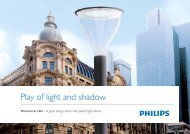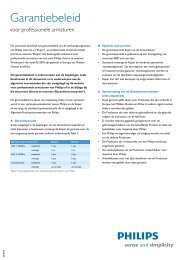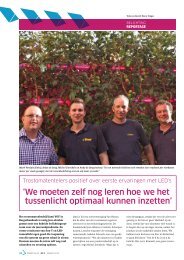Case study Valley View Greenhouses (PDF) - Philips Lighting
Case study Valley View Greenhouses (PDF) - Philips Lighting
Case study Valley View Greenhouses (PDF) - Philips Lighting
You also want an ePaper? Increase the reach of your titles
YUMPU automatically turns print PDFs into web optimized ePapers that Google loves.
<strong>Case</strong> <strong>study</strong><br />
<strong>Valley</strong> <strong>View</strong> <strong>Greenhouses</strong><br />
Location<br />
<strong>Philips</strong> <strong>Lighting</strong><br />
South Salem, NY, USA<br />
<strong>Philips</strong> GreenPower LED flowering lamps
“<strong>Philips</strong> LED lights managed to save us time<br />
and money while improving our plant quality”<br />
Background<br />
Frank Amodio has been the owner of <strong>Valley</strong> <strong>View</strong><br />
<strong>Greenhouses</strong> located in South Salem, NY since 1978.<br />
Frank graduated from Cornell University with a degree in<br />
ornamental horticulture, and has established a reputation<br />
for being a premier grower in Westchester County. Recently<br />
Frank’s son Kevin joined the <strong>Valley</strong> <strong>View</strong> team, making four<br />
generations of Amodios in the greenhouse industry, two at the<br />
current location. Clearly growing runs in Amodio blood!<br />
<strong>Valley</strong> <strong>View</strong> sells high quality finished products to local<br />
retailers and landscapers. Beginning in early spring with<br />
crops like Hydrangea, moving into mid-season with annuals,<br />
perennials and nursery stock, then on to the fall production<br />
of Chrysanthemums and other late season crops, and finishing<br />
up with Poinsettias, <strong>Valley</strong> <strong>View</strong> runs a year-round operation.<br />
Additionally, <strong>Valley</strong> <strong>View</strong> is a rooting station supplying the<br />
Northeast region with rooted cuttings for the Winter months.<br />
Challenge<br />
Light is an extremely crucial aspect of plant development,<br />
affecting maturity, bloom time as well as uniformity in size.<br />
A recent challenge at <strong>Valley</strong> <strong>View</strong> was finding a way to grow<br />
tuberous Begonias in a more compact, heavily branched habit<br />
during the short days of Winter. The goal was to have these<br />
plants ‘market ready’ for prime selling time, blooming when<br />
Frank wanted them to bloom while staying compact. In other<br />
words: not blooming too early or stretching.<br />
Solution<br />
<strong>Valley</strong> <strong>View</strong> installed <strong>Philips</strong> LED flowering lamps in<br />
certain areas of the greenhouses. Portions of the crops of<br />
non-stop Begonias (95%), Dragon Wing Begonias (25%) and<br />
New-Guinea Impatiens (20%) were placed under the new<br />
lights to run a comparison of growth against the same types of<br />
plants not placed under the flowering lamps.<br />
The lights were a combination of Deep Red and White which<br />
were chosen specifically for the crops being grown.<br />
The lights were turned on automatically at 7 PM and shut<br />
off automatically at midnight during the growing phase of<br />
the crops. There were no other changes made in terms of<br />
substrate, fertilization, or irrigation during this trial.<br />
The begonia baskets and larger pots were lit until March 18th,<br />
the 4.5” pots were lit until March 25th. Frank planned the<br />
lighting schedule around their ‘market ready’ date, which for<br />
<strong>Valley</strong> <strong>View</strong> is early/mid May.
The goal was ‘market ready’ for<br />
prime selling time, blooming when<br />
wanted, while staying compact<br />
Facts<br />
Grower<br />
Frank Amodio<br />
Sector<br />
Potted, Bedding Plants, and Perennials<br />
Crop<br />
Tuberous Begonia, Dragon Wing Begonia,<br />
New Guinea Impatiens<br />
Location<br />
South Salem, NY, USA<br />
Solution<br />
<strong>Philips</strong> GreenPower LED flowering lamps<br />
<strong>Philips</strong> LED Horti Partner<br />
Fred C. Gloeckner & Company Inc.<br />
Results<br />
Uniformity, Consistency, and early bloom time<br />
on all crops<br />
Benefits<br />
The new spectrum lighting was a success across the board on all<br />
the Begonias. All benches were consistent across the top. Frank<br />
was able to achieve the desired result he strove to accomplish<br />
with his tuberous begonias in the first year of production using<br />
the <strong>Philips</strong> LED flowering lamps.<br />
Specifically, the high shrinkage rate of 12% experienced in the past<br />
at <strong>Valley</strong> <strong>View</strong> with the growth of tuberous Begonias was reduced<br />
to 1% - a truly phenomenal improvement. The tuberous Begonias<br />
grown under the lights all bloomed at the same time and were<br />
able to remain pot tight for a longer length of time. Very little<br />
stretching was found and the plants displayed strong stems to<br />
support the flowers. The comparison crop, grown under regular<br />
incandescent lighting, achieved the same disappointing results<br />
as in years past, flowering too early with weak stems. Another<br />
significant savings was using 1 application of Cycocel on their<br />
hanging basket crop as opposed to 2 applications on the unlit<br />
crop grown under regular incandescent lights.<br />
The dragon wing begonias also tested under the <strong>Philips</strong> LED<br />
flowering lamps experienced the same results as the tuberous<br />
Begonias. The real benefit with the Dragon Wing Begonia hanging<br />
baskets was that they did not bloom too early! Botrytis did not<br />
form on the bench crops below them, since the blooms did not<br />
form and fall off the hanging baskets early as in previous year’s<br />
production. The unlit comparison crop of Dragon Wing Begonias<br />
flowered earlier and needed more maintenance and cleaning,<br />
costing more labor hours on the crops growing underneath them.<br />
The final test of New Guinea Impatiens rendered dream<br />
results with the use of the <strong>Philips</strong> LED flowering lamps. The<br />
crop was uniform and remained pot tight until market date. In<br />
short, the crop was perfect! However, <strong>Valley</strong> <strong>View</strong> did notice a<br />
variable change on the New Guinea Impatiens bench during the<br />
propagation in that the heat was turned up higher this year on<br />
the trial bench. They will have to try it again next year with the<br />
heat at the normal temperature to confirm that the lights, not the<br />
heat created the uniformity. They will also use the LED lights on<br />
the New Guinea Impatiens to see if they can speed up flowering<br />
for a few weeks.<br />
The overall results for all of the trials were a resounding success.<br />
The elimination of shrinkage, the reduction of labor for cleaning<br />
and spacing, and the high quality plants produced were significant<br />
improvements over past growing seasons. The resulting increase<br />
in profit margin offset any initial startup investment!
© 2013 Koninklijke <strong>Philips</strong> Electronics N.V.<br />
All rights reserved. Reproduction in whole or in part is prohibited without the prior written consent of the copyright owner. The information<br />
presented in this document does not form part of any quotation or contract, is believed to be accurate and reliable and may be changed without<br />
notice. No liability will be accepted by the publisher for any consequence of its use. Publication there of does not convey nor imply any license<br />
under patent- or other industrial or intellectual property rights.<br />
07/2013<br />
Document order nummer: 3222 635 67603<br />
www.philips.com/horti
















